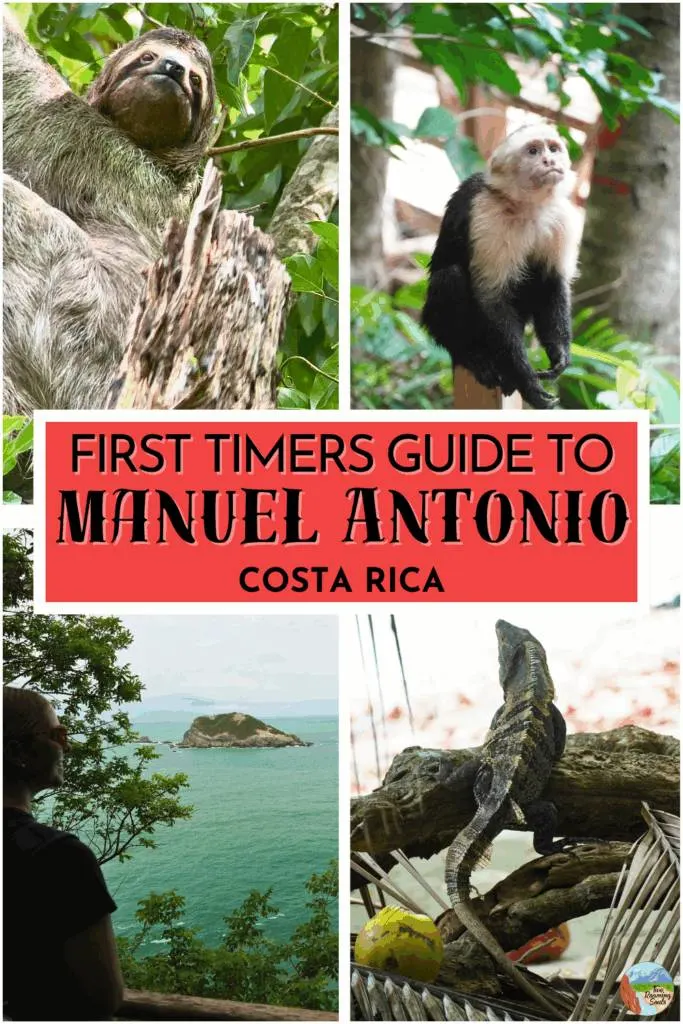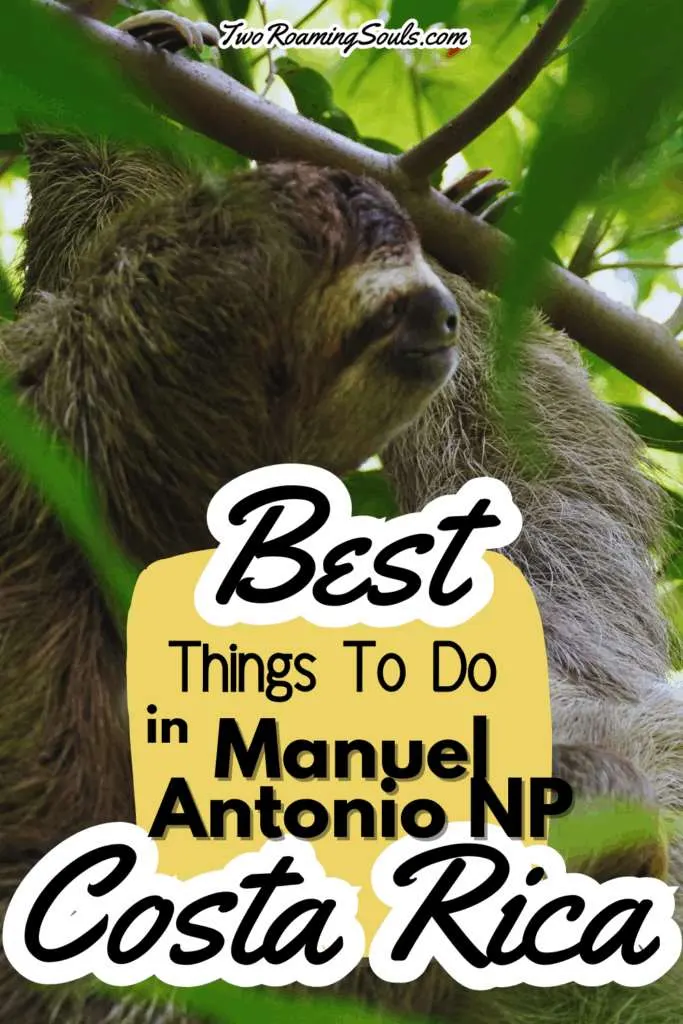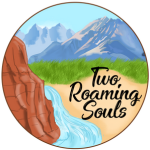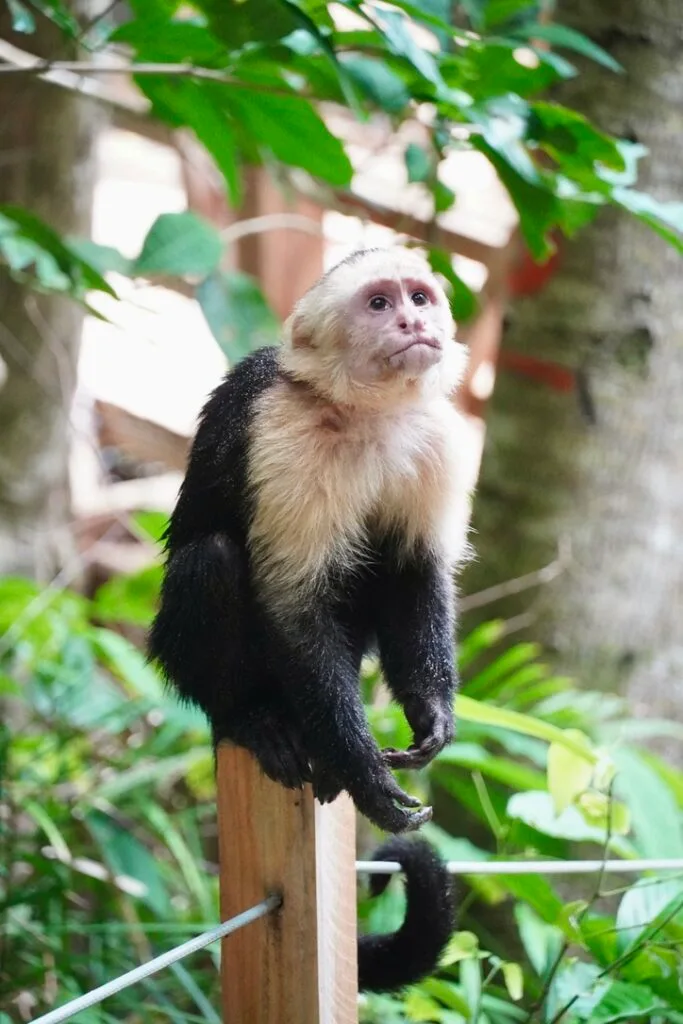
Manuel Antonio National Park is a small park on Costa Rica’s Pacific coast, famous for beautiful beaches and biodiverse rainforest. With highlight species like sloths, monkeys, lizards, frogs, and many more.
In this guide we will tell you everything you need to know about visiting Manuel Antonio National Park. Like how to get there, admission fees, park attractions, and the forever debated question, “do you need a guide?”
We’ll also cover how to navigate the clunky reservation website, the stingy list of prohibited items, bag searches, and other more unexpected hurdles for visiting the park.
This post may contain affiliate links. Disclosure policy.
How To Get To Manuel Antonio National Park
Manuel Antonio is located on the central Pacific coast, just south of the town of Quepos. It’s about a 2 and a half-hour drive from the closest international airport located in the capital city, San Jose. (aka: Juan Santamaria Airport [SJO])
There are pricey 30-minute domestic flights between San Jose and Quepos, but most people get here by car, shuttle van, or bus.
Rental cars are a good option for exploring Costa Rica on your own schedule and venturing a little off the beaten path. We took that the next level by renting an overloading camping rig from Nomad America. You can check out our video all about that experience here.
But shuttles and buses are another popular way to reach Manuel Antonio that leaves the driving up to someone else.
And you can even book tours that include transportation all the way from San Jose. We will link some in the description.
If you do drive yourself here, an important thing to know is that the park doesn’t manage any of its own official parking.
So, as you approach the park you will be flagged down constantly by parking attendants hoping to fill their lots. Sometimes over 20-minutes walk from the entrance of the park. They will even look official with reflective vests. But especially if you are getting there early, just ignore them and drive as close to the park entrance as you can and find the closest lot that isn’t full.
When we booked our tour with Viator, they saved us a parking spot right outside the park! (It was an additional $10 to park for the day).
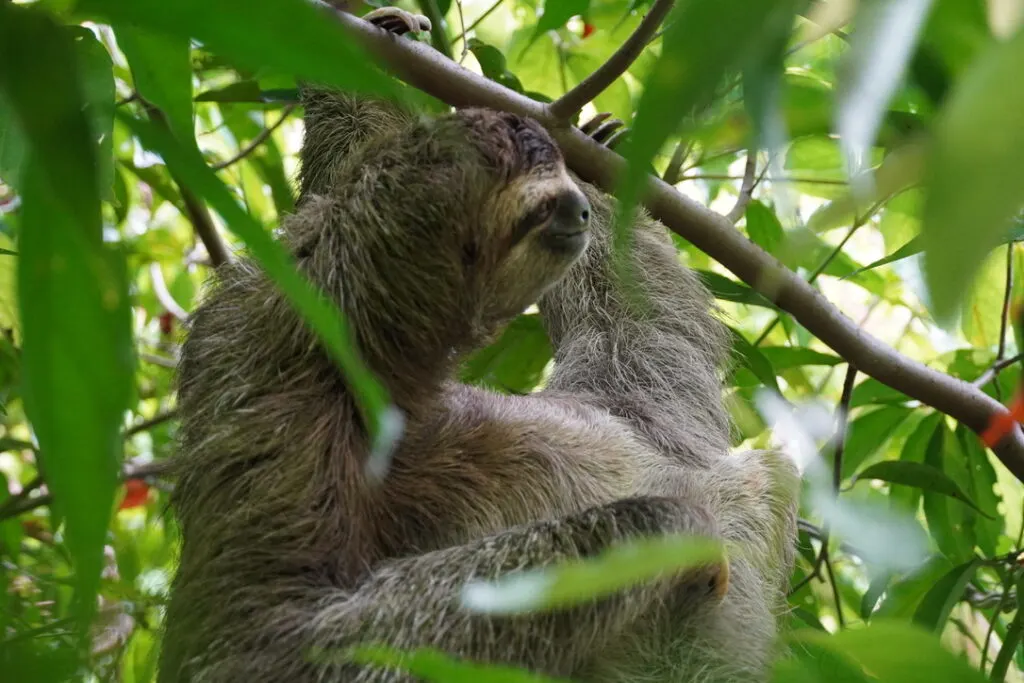
Fees and Tickets
Admission to Manuel Antonio National Park is $18 US dollars for foreign adults and $5.65 for kids ages 2-11.
The park is open to admission from 7am to 3pm everyday. Except for Tuesdays when the park is closed. All reservations are good for one day, and you need to leave the park by 4pm. So some of the farther away attractions close at 3 to allow time for walking to the exit.
Something VERY important to know is that you need to book your admission tickets for the park online before arriving. It’s actually a bit of a tricky process, so we’ll cover the whole thing in detail at the end of the video.
And admission tickets have timed-entry slots, but, once you’re in, you can stay as long as you like until they close.
Don’t Forget Travel Medical Insurance!
Having travel medical insurance is essential when you’re exploring outside your home country. Your regular health insurance often won’t cover you abroad — and unexpected medical expenses can be costly. That’s where SafetyWing comes in. It’s one of the most affordable travel medical insurance options available, offering worldwide coverage with a $0 deductible. It’s the peace of mind you need to travel confidently, knowing you’re protected in case something goes wrong.
Use the cost calculator below to check what it would cost for your trip:
Park Attractions
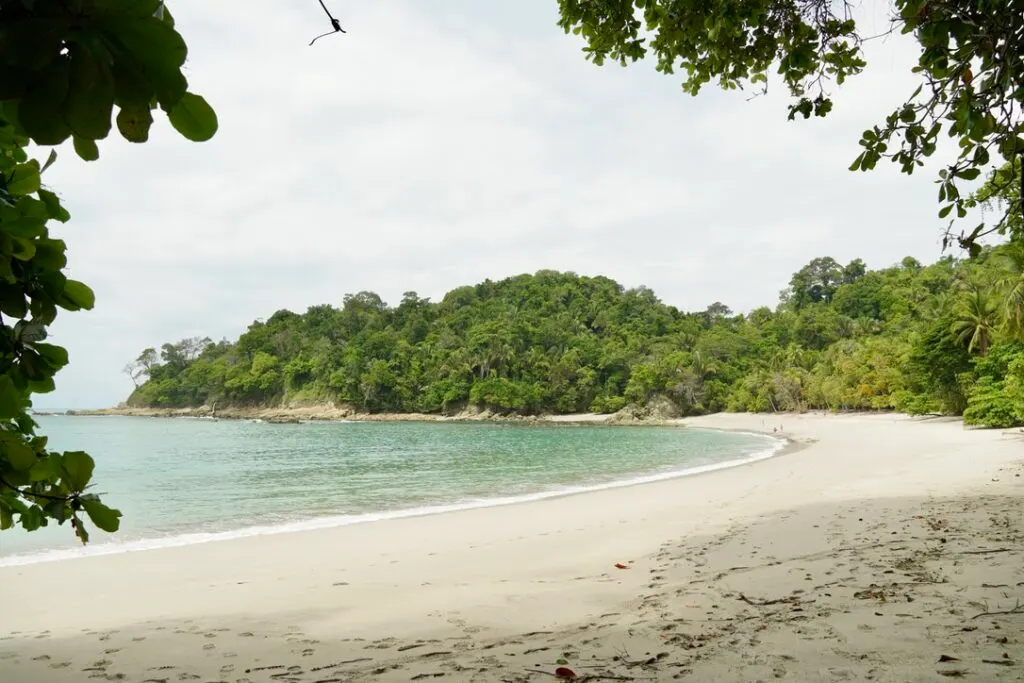
The primary attractions in the park are the wildlife and the beaches. The coast is famous for a prominent peninsula, or more accurately described as a tombolo, which is formerly an island that is now connected to the mainland by sand.
This gorgeous Tombolo/peninsula is flanked by beautiful beaches on both sides.
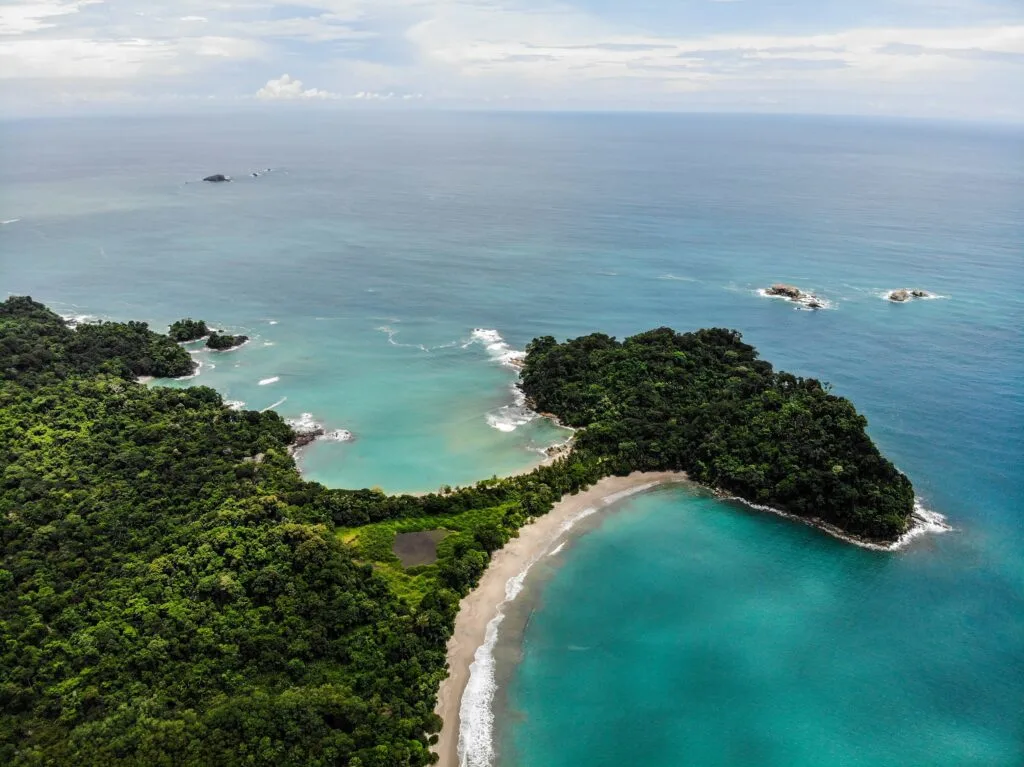
And inland, there is lush rainforest and brackish wetlands full of mangroves.
Here are some of the primary destinations in the park:
- Manuel Antonio Beach is the most popular in the park. It’s a very scenic cove beach on the left side of the peninsula, that is best for swimming and snorkeling. And it has some rocky tide pools at the edges.
- Espadilla Sur Beach makes up the right side of the peninsula. Still beautiful, But is a less popular due to larger waves at times.
- Gemelas Beach is a small rocky cove with bigger waves, so it’s not recommended for swimming, but will be way less crowded than the other beaches.
- Punta Catedral is the former island that makes up the tip of the tombolo. A hilly, but well-maintained trail around the tip takes you to several awesome viewpoints and is a great place to observe seabirds.
- The 18 hectares of Mangroves in the middle of the park host many wetland plants and animals.
- And there is a Waterfall trail, but check with park staff because only flows seasonally.
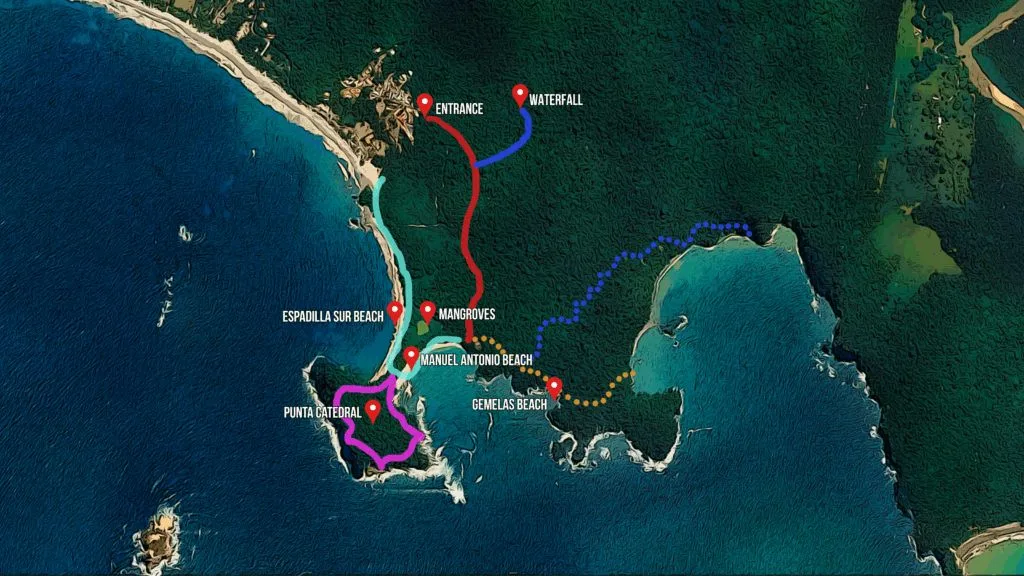
The park is only accessible on foot. So visitors should expect to do some light hiking over somewhat hilly terrain.
There are about 8kms (≈ 5 miles) of well-maintained trails throughout the park that you can explore freely on your own, or with a guide.
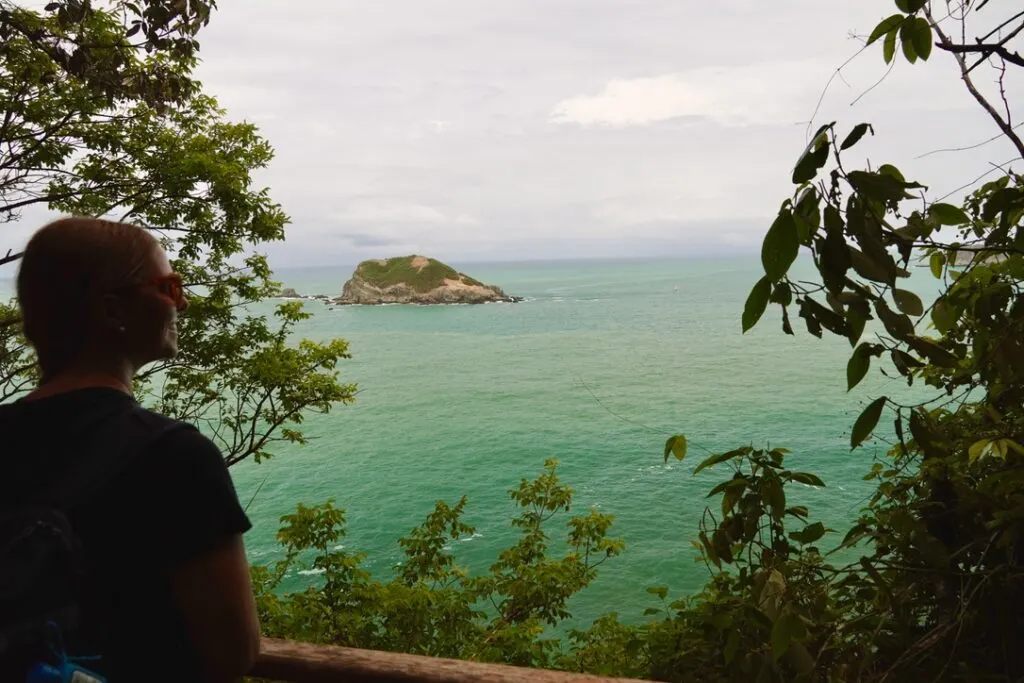
But I would say that a more typical visit to the main attractions includes walking about 1.5 to 3kms (≈ 1-2miles).
Even those with limited mobility can still enjoy the park, as there are several sections of flat boardwalks. With plenty of chances to see wildlife. But you might have a hard time reaching the beaches and farther destinations in the park.

Seeing wildlife is probably the main draw for most visitors. And for good reason, the park is just teeming with biodiversity. And many species have grown comfortable with the presence of humans, some perhaps a little too comfortable.
Like so much so, that the only place you can buy and consume food in the park is contained within a giant metal cage. Without it, monkeys and raccoons would just be stealing your lunch, left and right. So it’s a necessary move to help keep the wildlife wild. But it does kind of feel like a real Planet of the Apes situation.
Do You Need A Guide For Manuel Antonio National Park?
For spotting wildlife, the main decision that visitors face is whether to go it on your own, or hire a naturalist guide.
We hired a guide for our visit, but also did plenty of other hikes in Costa Rice without one.
Just inside the park entrance, you can find the Manuel Antonio Official Tour Guides. You can reach them via this phone number or email: (506) 86711813 or maofficialtourguide@gmail.com
Or we hired a shared group guide through Viator and got lucky since I guess nobody else signed up, so it was just the three of us. And our guide Luis was excellent, so friendly, knowledgeable, and patient.
The main benefits of having a guide is that they will show you many more animals that you would almost certainly miss on your own.
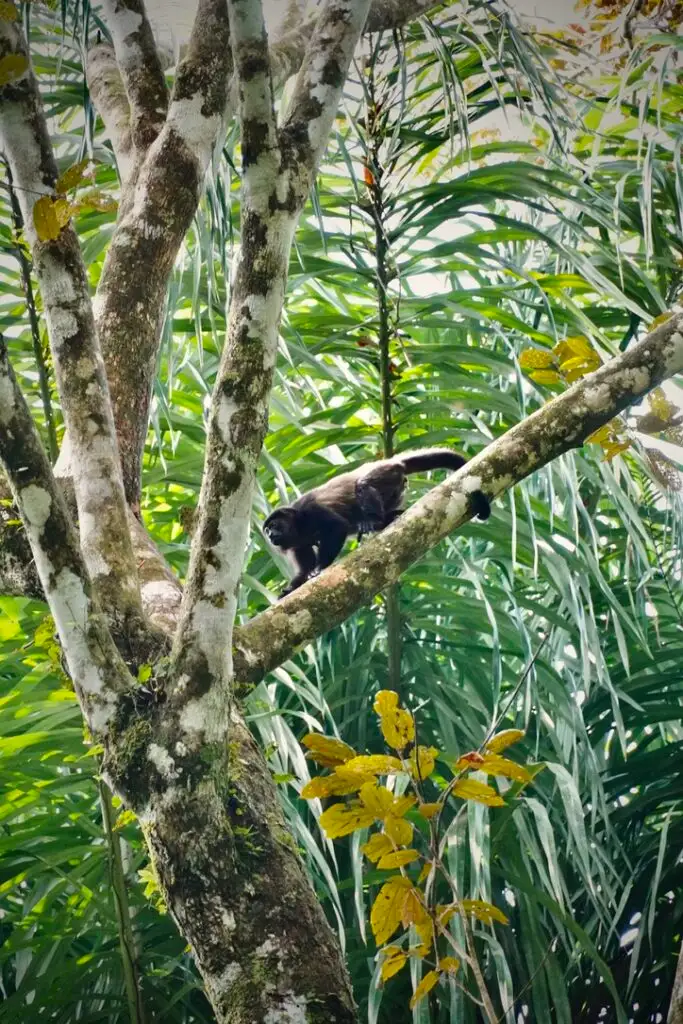
Some of the most obvious species like monkeys, lizards, and crabs, anyone can spot. But there are plenty of rarer, more elusive species that would be hard to see without a guide.
And guides just have such an intimate knowledge of these ecosystems and the plants and animals that inhabit them. Their senses are very tuned in to the sights, sounds, and smells of the environment.
They have a nuanced understanding of where certain animals can likely be found, what plants they like to eat, how seasons affect their behaviors, and so much more.
Our guide would hear bird calls and seconds later have his scope set on a beautiful bird. Or he even found several bats high up in the tree canopy, that we would have NEVER seen on our own.
And unless you have a really fancy pair of binoculars or zoom lens, the guides’ visual scopes provide a comfortable way to get amazing views of these animals. And what’s more, our guide even had a special setup to attach our phones to the scope, and he helped us get incredible photos and videos.
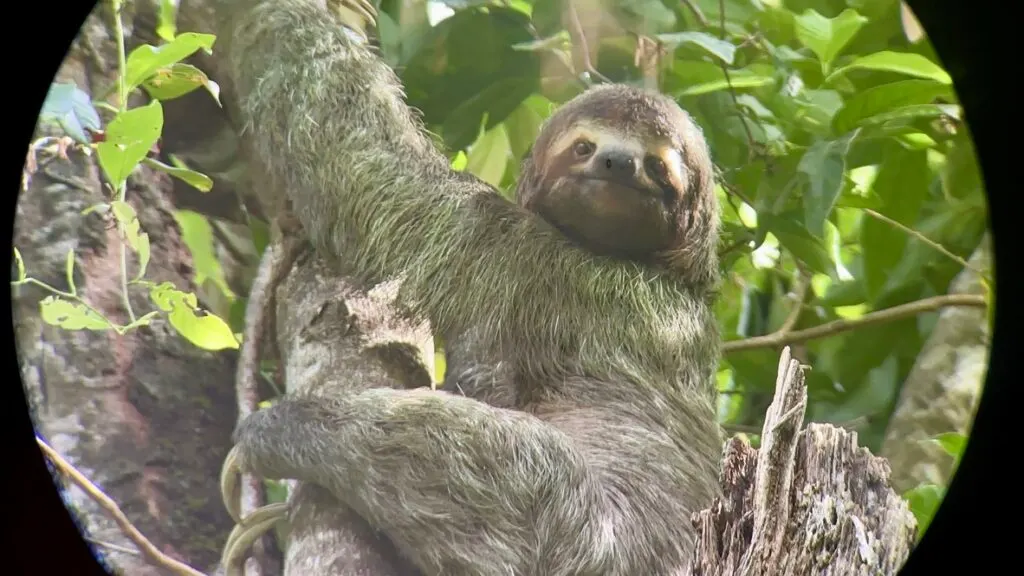
The phone works as a vibrant display that everyone can look at together. While simultaneously, you can be recording video or snapping photos. Cuz, let’s be honest, you are obviously going to want to show your family and friends.
And besides just locating animals, guides share so much interesting context and passion about the environment. You can ask them questions and ultimately gain a greater appreciation of what you’re seeing.
But the rather awkward thing is that even if you don’t hire a guide, it’s hard not to benefit from their skills.
And this goes for most other guided nature walks in Costa Rica. You are sure to come across guide groups who are all gathered and looking at something. So even though you didn’t pay for the guide, you’re not going to not look at what they’re seeing. I mean, it’s just human nature.
And there becomes this kind of awkward dynamic where people without guides can’t help but piggyback off the guide groups anyway. Some subtly and some not so subtly.
But personally, on other hikes we did in Costa Rica, we didn’t feel very comfortable mooching off them if we didn’t pay for their services.

The bottom line is that unless you are a skilled naturalist yourself, a good guide will greatly improve your experience!
And ultimately, these are the kinds of people I love to support with my money. Passionate individuals who help bring awareness to the natural world and the importance of protecting it.
Wildlife
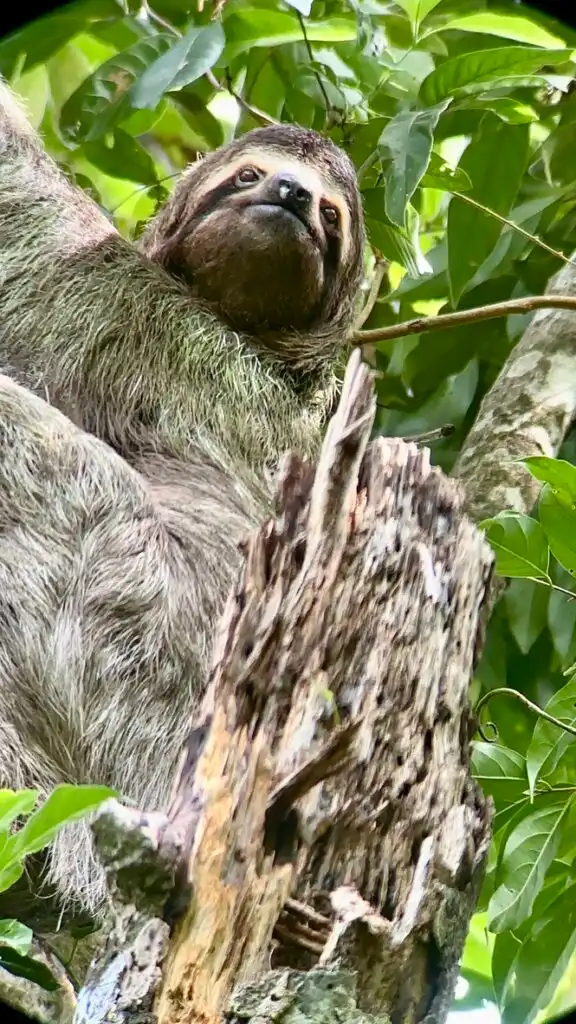
Some of the most popular and obvious species in the park are sloths, monkeys, and lizards.
Three-Toed and Two-Toed sloths are probably the thing we were most excited to see. They are found all over Costa Rica, but we didn’t have too much luck spotting them during the rest of our trip.
The Three-Toed sloth is the one that looks kind of like it’s wearing a mask, and they are much more common to see. We encountered several during our visit. Two-toed sloths are larger, with white-ish brown fur, but they are a little harder to see.
The thing about sloths is that they don’t make much noise, and they move very slowly. So they can actually be quite hard to spot. Our guide informed us that they are usually higher up in the trees during the rainy season, which also made locating them difficult.
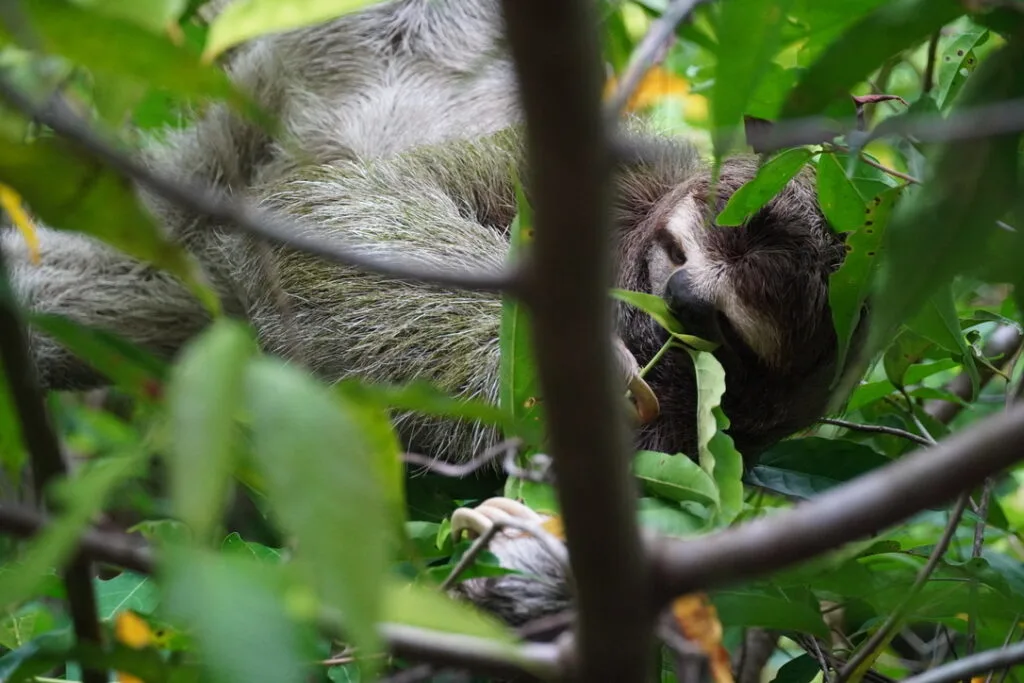
Another thing we learned was that a sloth’s fur has a green tint. Well, our guide taught us the kind of gross but fascinating reason behind it. Insects live in their fur, and their excrement fosters algae growth. And the green algae helps the sloths with camouflage. So weird!
The two species of monkeys that you are almost guaranteed to see are the very mischievous white face capuchins and the loud and boisterous howler monkeys. But the smaller squirrel monkeys and spider monkeys are more elusive, and we didn’t spot any at all on our trip.
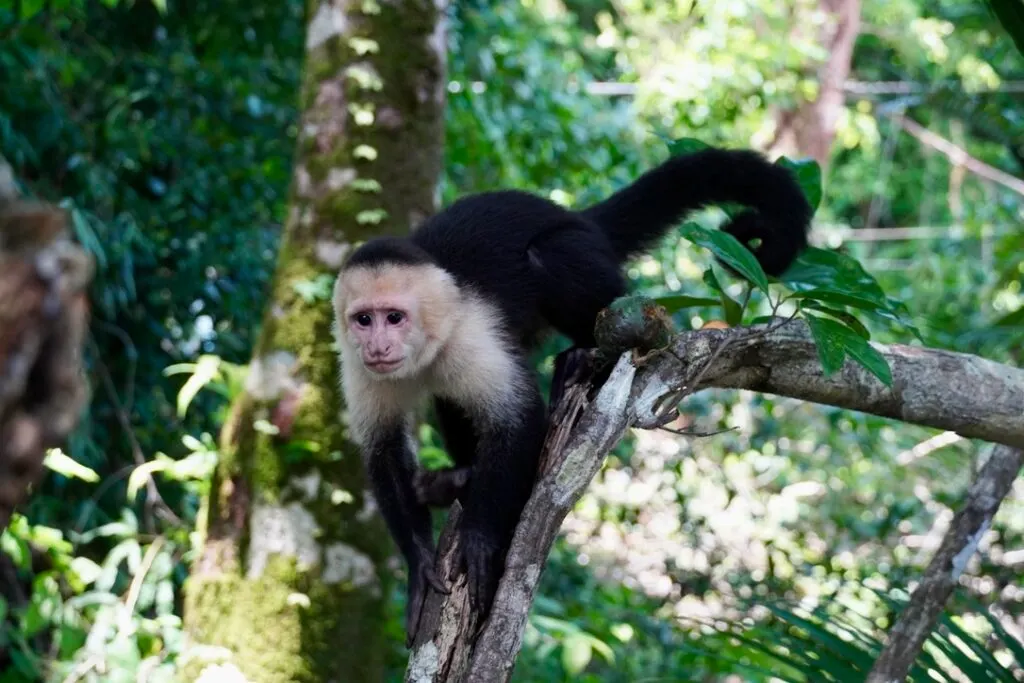
You need to be very careful around monkeys, especially the white-faced ones. They are not afraid of humans and have learned that they can bully or frighten people to steal our things.
And I know, they look so cute, and it’s hard to resist getting closer. But you need to keep your distance, guard your belongings, and try not to smile at them, or make eye contact for too long. The show of teeth can be misread by them.
Luckily, human and monkey encounters have gotten much better once outside food was banned from the park, but more on that later.
Our guide taught us a funny nickname for capuchins is the scarface monkeys, as this one’s face makes the name quite obvious.
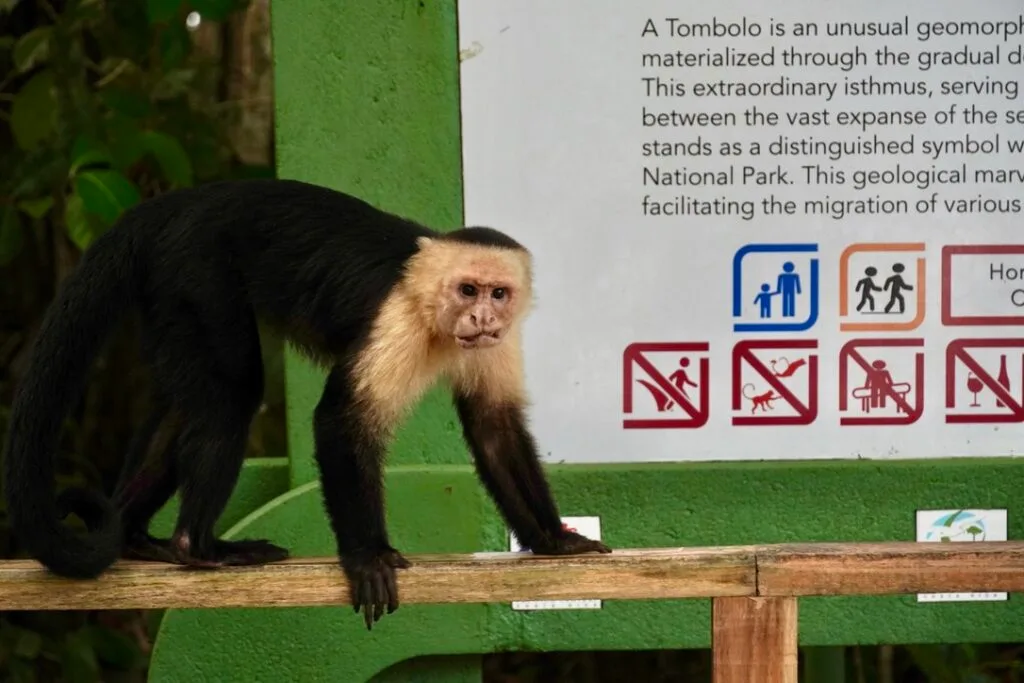
Another easy-to-find species is the black iguana or spiny tailed iguana. They are quite large and impressive, and usually hang around the beaches.
There are over 350 known species of birds that visit or inhabit the park. With some of the most famous ones being the Yellow-Throated Toucan and the Fiery Billed Aracari.
And the leaf-cutter ants are another species that we were always amazed by during our trip to Costa Rica.
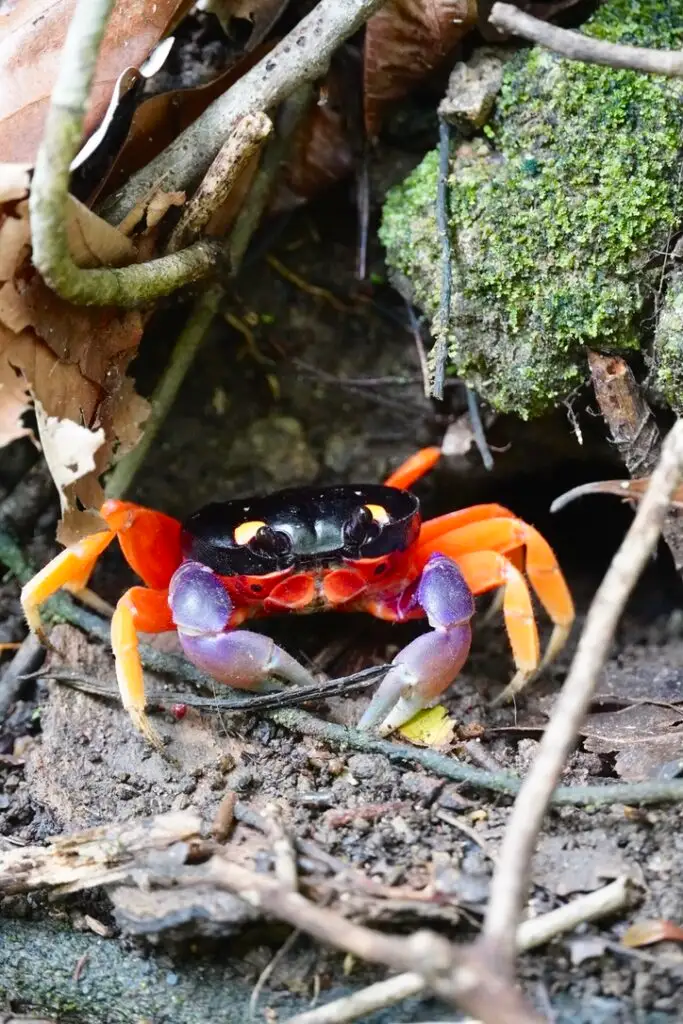
These colorful Halloween crabs are also all over the park too.
Other rarer species that you can sometimes see are crocodiles in the mangroves, anteaters, frogs, and the Jesus Christ lizards are the ones that can literally run cross the surface of water.
Prohibited Items
Something the park takes very seriously is the list of prohibited items. And they search everyone’s bags upon entry for compliance.
I appreciate their commitment to preserving these parks with strict rules, but they can definitely pose a little bit of a surprise or inconvenience to the unprepared.
No single-use plastic of any kind is allowed in the park, which includes plastic water bottles. So bring a reusable water bottle if you have one. We personally bring our Lifestraw Go Series Insulated Water Bottle on international trips, when the water might not be up to our normal standard. They have numerous refill stations throughout the park.
Also, no outside food is allowed in. So I recommend eating something before entering the park. Once you are inside, you can only get food at the one cafeteria I mentioned earlier that is inside the metal cage. And from what I could tell from other visitors, the food seemed underwhelming and overpriced. You know, with the literally captive audience and all.
Alcohol and tobacco are also not permitted.
Many people might envision having a nice beach day in the park. And the beaches are certainly worth visiting. But on the list of prohibited items are chairs, umbrellas, tents, awnings, and hammocks. You know, like anything someone might bring besides a towel to make their beach day more comfortable.
Luckily, there is some shade from trees, but for the most part I think most people only stay at the beaches for a little bit before they get too hungry or uncomfortable.
But one nice feature they have are foot wash stations, outdoor showers, and restrooms. So feel free to bring a change of clothes if you plan to go swimming at the beach.
Other things that are not allowed is any form of aerosol sunscreen, tanner, or insect repellent. So stick to non-pressurized sprays or lotions.
And for what it’s worth, other than the beaches, we found that most of the park’s trails are pretty well shaded.
Also, drones are not allowed.
When To Visit Manuel Antonio National Park
Dry season is from December to April and is the most popular time to visit because there is very little rain. And as you might suspect, it is also the busiest time to visit. So expect higher prices on accommodation and to share the park with more people.
The rainy season, or Green season, is from May to November, with rainfall peaking around October. But rainy season doesn’t just mean rain all day, every day. You can still get sunshine, especially around the shoulder seasons and in the mornings.
Regardless of the time of year, the best way to beat the crowds, is to book the earliest available time slot. That way, you are one of the first people on the trails and have the best chance of seeing wildlife.
And I know 7am might sound early, but the sun rises between 5 and 6 am year-round in Costa Rica. So it’s pretty easy to get on an early schedule.
How To Book Your Reservation Tickets
The only place to get tickets is on the SINAC website, a government site that translates rather poorly into English.
I’m going to walk you through this whole process because even though I can read a little Spanish, I still found it a bit challenging.
You can click the video below to show you a step-by-step guide to booking your tickets.
Is It Worth Visiting Manual Antonio National Park?
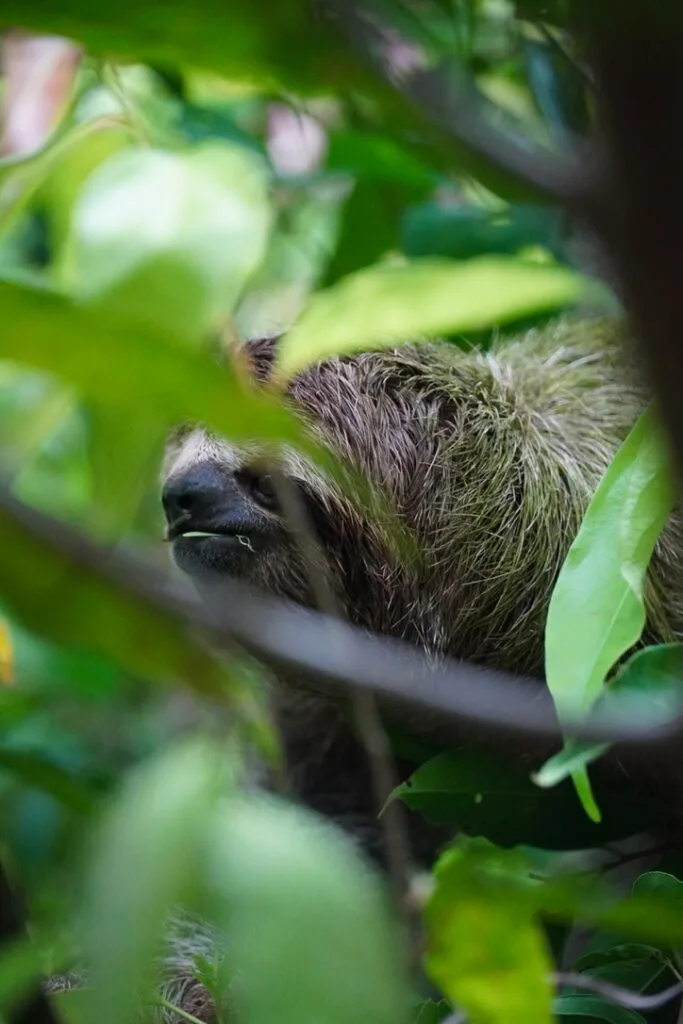
While Manuel Antonio is by no means the only place to see wildlife in Costa Rica, it’s one place where you are practically guaranteed to see wildlife, and lots of it.
And for people only visiting Costa Rica for a short period, that is certainly an enticing factor.
And there is plenty of accommodation, restaurants, and beaches to entertain you outside of the park.
Despite Manuel Antonio’s popularity, the area still strikes an acceptable balance between development and nature.
If you plan on coming here, and hiring a guide, we recommend doing it early in your trip. The guide will teach you some useful skills that might help you spot wildlife during the rest of your trip.
We foolishly did the opposite, coming here on our last day.
Cuz again, spotting wildlife without a guide can be quite a challenge. Honestly, a lot of us just don’t have the patience required to locate rarer species.
If you don’t hire a guide, our best advice is to sloooooow down and really take your time to look and listen. That is when the subtleties of the forest reveal themselves to you.
Where To Stay Near Manuel Antonio National Park
While there is no accommodation inside the park, there are some great places to stay outside the park.
- WORLD FAMOUS 727 Airplane Jungle Fuselage – Closest location to the park, just about the coolest accommodation you can find! But definitely a bit pricey!
- Hotel Manuel Antonio – Located on the beach, about a 5-minute walk to the Manual Antonio entrance.
- Costa Linda Art Hostel – Best budget option, 8-minute walk to the Manual Antonio entrance, basic amenities, shared rooms/bathrooms
You can also find many great accommodations in the town of Manuel Antonio or Quepos. Use the helpful map and filters below to find your perfect stay.
Save This Post For Later
